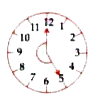What is the radian measure of the smaller angle formed by the hands of a clock at 7 o'clock?
π2
2π3
5π6
7π6
The correct Answer is:C
To find the radian measure of the smaller angle formed by the hands of a clock at 7 o'clock, we can follow these steps:
Step 1: Understand the positions of the clock hands
At 7 o'clock, the hour hand is on the 7 and the minute hand is on the 12.
Step 2: Calculate the angle for one hour interval
The entire clock represents a full circle, which is 2π radians. Since there are 12 hours on a clock, the angle for each hour interval is:
Angle for one interval=2π12=π6
Step 3: Determine the number of intervals between 7 and 12
To find the angle between the hour hand at 7 and the minute hand at 12, we need to count the number of hour intervals from 7 to 12:
- From 7 to 8: 1 interval
- From 8 to 9: 2 intervals
- From 9 to 10: 3 intervals
- From 10 to 11: 4 intervals
- From 11 to 12: 5 intervals
Thus, there are 5 intervals between 7 and 12.
Step 4: Calculate the total angle between the hands
Now, we can calculate the total angle formed by the hour hand and the minute hand:
Total angle=Number of intervals×Angle for one interval=5×π6=5π6
Step 5: Identify the smaller angle
Since the total angle between the hands is 5π6 radians, and this is less than π radians, it is already the smaller angle.
Final Answer
The radian measure of the smaller angle formed by the hands of a clock at 7 o'clock is:
5π6 radians
---
At 7 o'clock, the hour hand is on the 7 and the minute hand is on the 12.
The entire clock represents a full circle, which is 2π radians. Since there are 12 hours on a clock, the angle for each hour interval is:
Angle for one interval=2π12=π6
To find the angle between the hour hand at 7 and the minute hand at 12, we need to count the number of hour intervals from 7 to 12:
- From 7 to 8: 1 interval
- From 8 to 9: 2 intervals
- From 9 to 10: 3 intervals
- From 10 to 11: 4 intervals
- From 11 to 12: 5 intervals
Now, we can calculate the total angle formed by the hour hand and the minute hand:
Total angle=Number of intervals×Angle for one interval=5×π6=5π6
Since the total angle between the hands is 5π6 radians, and this is less than π radians, it is already the smaller angle.
The radian measure of the smaller angle formed by the hands of a clock at 7 o'clock is:
5π6 radians
Topper's Solved these Questions
- BOOK - ENGLISH SATCHAPTER - ADDITIONAL TOPICS IN MATHEXERCISE - Grib-In32videos
ADDITIONAL TOPICS IN MATH
- BOOK - ENGLISH SATCHAPTER - ADDITIONAL TOPICS IN MATHEXERCISE - EXERCISE45videos
ADDITIONAL TOPICS IN MATH
- BOOK - ENGLISH SATCHAPTER - ADDITIONAL TOPICS IN MATHEXERCISE - EXERCISE45videos
ADDITIONAL TOPICS IN MATH
- BOOK - ENGLISH SATCHAPTER - ADDITIONAL TOPICS IN MATH EXERCISE - PRACTICE TEST24videos
ADDITIONAL TOPICS IN MATH
- BOOK - ENGLISH SATCHAPTER - COMPLEX NUMBERSEXERCISE - EXERCISE6videos
COMPLEX NUMBERS
Similar Questions
Knowledge Check
- Question 1 - Select One
What is the degree measure of the smaller of the 2 angles formed by the line and the ray shown in the figure below?
 A14∘B28∘C29∘D58∘
A14∘B28∘C29∘D58∘ - Question 2 - Select One
What is the angle measure of 4 radians ?
A114.591∘B141.372∘C229.183∘D282.743∘
The locus of the moving end of the minute hand of a clock.
View SolutionName the type/types of motion being performed by the Hands of a clock
View SolutionCalculate the angular speed of the hour hand of a clock .
View SolutionFind the angle between the minute hand and the hour hand of a clock at 7.20 am
View SolutionWhat is the angular velocity of (a) a second hand and (b) minute hand of a clock ?
View SolutionFind the angular speed of the minute hand of a clock.
View Solution


